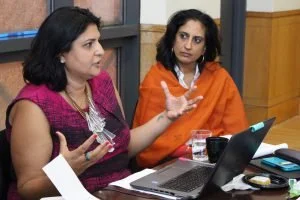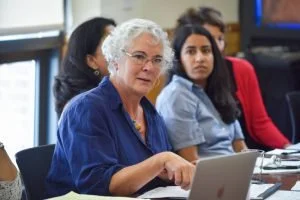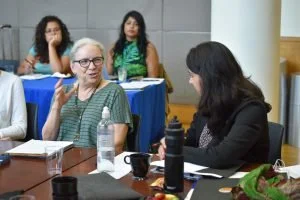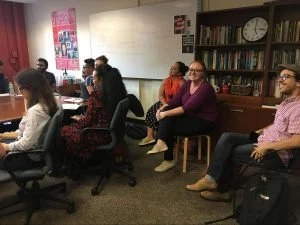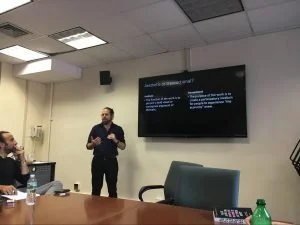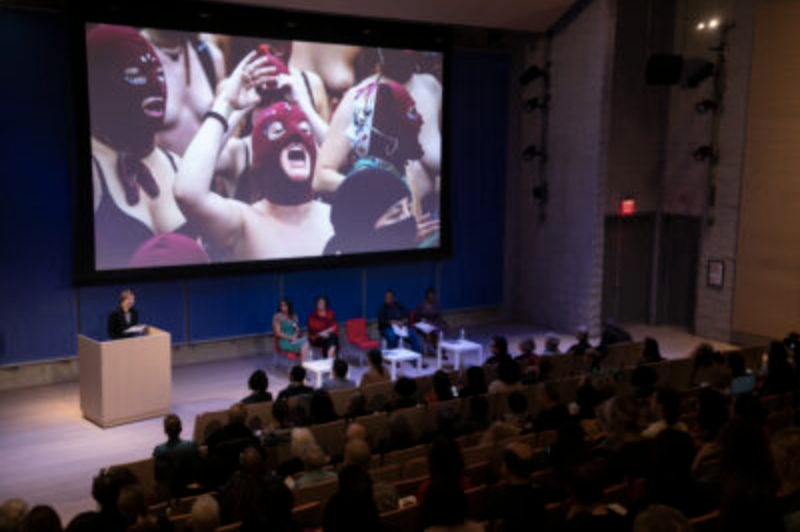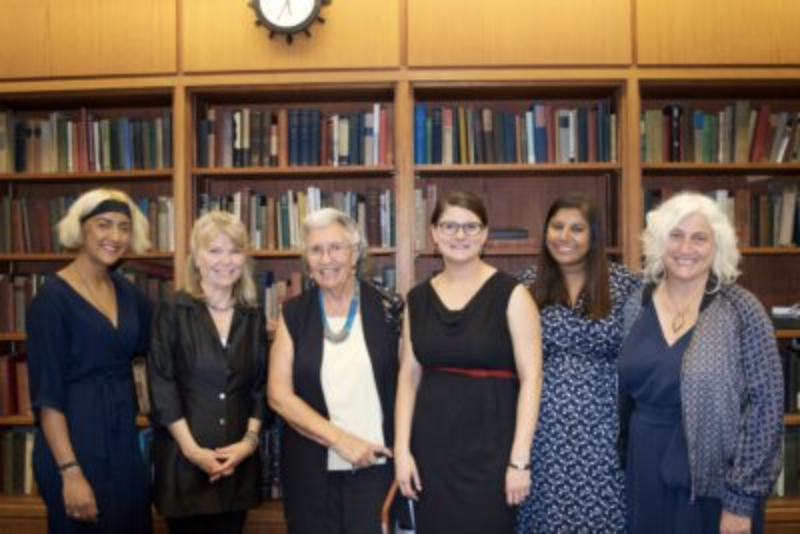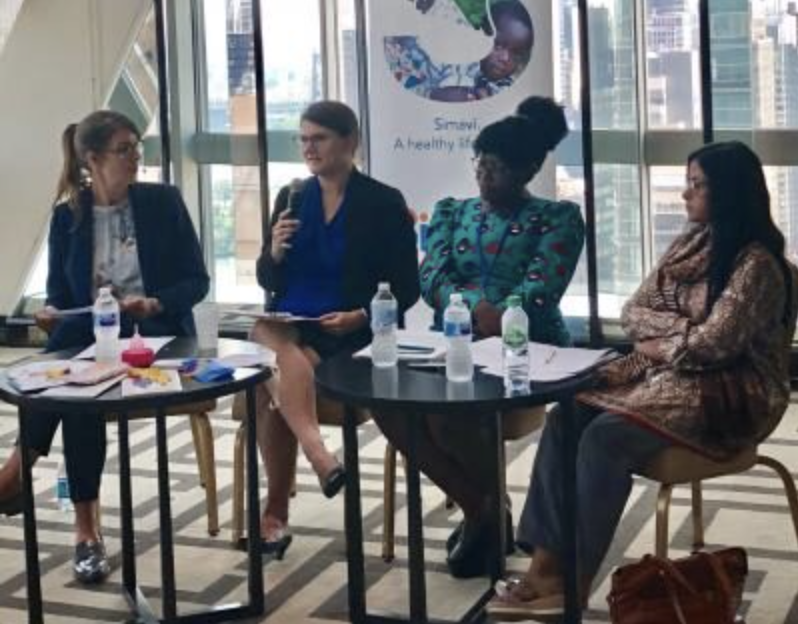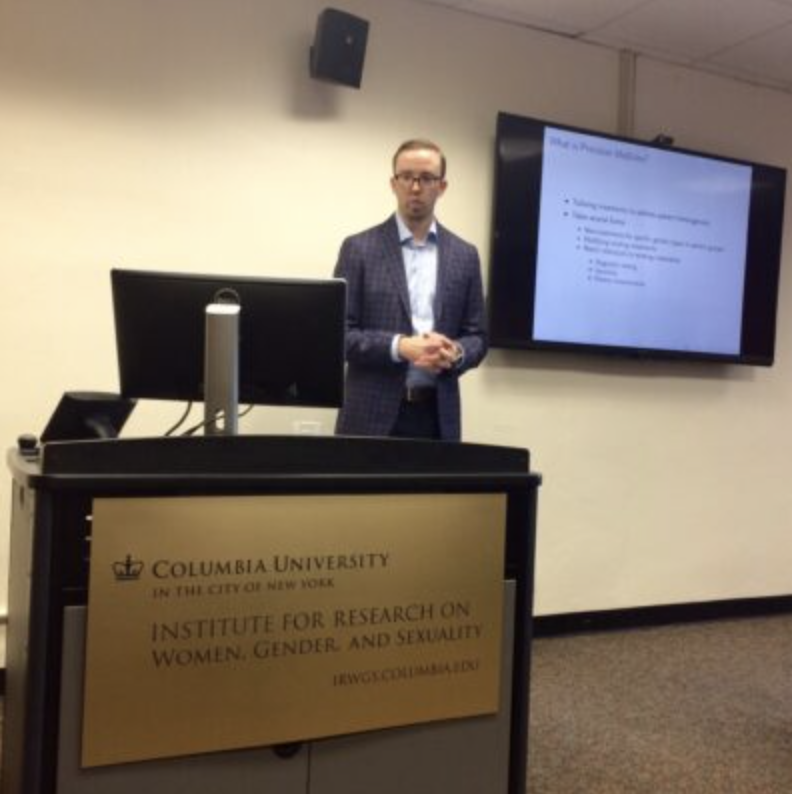The project on Religion and the Global Reframing of Gender Violence (RGFGV) convened a major international workshop on September 7-8, 2018. Global Governance of the Intimate was the second in a series of international workshops that opened with workshop in Amman a year earlier, hosted at the Columbia Global Center | Middle East, Amman. A group of twenty-five scholars, journalists, lawyers and activists met for two intensive days of collaborative research sharing and brainstorming at Columbia University in New York City.
The RGFGV project seeks to track and analyze the growing prominence of the global agenda against “violence against women” (VAW) and “gender-based violence” (GBV), whether in international law and global governance, practical interventions, or international media coverage. Participants and organizers who had presented at the Amman workshop opened the first session with an overview of how the three conceptual domains that had organized the earlier work of the project intersected with the new scholarship being presented. The key themes were: Narratives and the Framing of VAW/GBV, Alternative Trajectories and Experiences, and Governance and Resource Distribution.
Urgent questions that had emerged under the theme of Narratives and Framing of VAW/GBV had included the following: How do certain aspects of social life become labeled VAW or GBV? What actors or phenomena get highlighted under these rubrics, and which disappear? Do these narratives racialize religion or culture? Leti Volpp had examined how the insertion of “honor killings” in both versions of the U.S. Executive Orders now referred to as the “Muslim travel ban” worked to frame VAW/GBV in terms of religious difference and has implicated GBV in national governance. Sara Ababneh’s presentation at the New York workshop expanded this discussion by analyzing how intimate violence was portrayed differently in Jordan and the U.S..
Although co-director Nadera Shalhoub-Kevorkian was unable to attend the NYC workshop, Rema Hammami gave some background on her previous contribution on the everydayness of state violence as experienced by Palestinian school girls in occupied East Jerusalem. She had shown how the dominant frames of GBV are unable to recognize either the gendered violence of colonial rule or the sexualization of everyday surveillance. Nadje Al-Ali’s work picked up on these questions of how to analyze gender based violence in the Middle East, exploring dilemmas and tensions she has faced as a feminist scholar and activist researching VAW/GBV, whether in her previous work in Iraq or her new work on the Kurdish women’s movement and queer feminist activism in Lebanon.
Shahla Talabi, whose earlier contribution to the Amman workshop had been a sensitive analysis of the specific inflections of rape narratives in the cases of three former Iranian women political prisoners discussed Zahra Ali’s presentation on feminist mobilization in Iraq. In the current Iraqi context, she showed how Islam is used by both religious and secular forces to undermine feminist demands.
The kinds of questions posed under the theme of Governance and Resource Distribution related to how the anti-VAW/GBV agendas have been implicated in practices of governance and governmentality and in particular the networks through which GBV/VAW have emerged as key to global, national and local agendas. Hammami summarized the paper she had presented in Amman on the distributional effects of the global GBV agenda. She had studied “humanitarian GBV” in Gaza, detailing the ways that local women’s NGOs, starved for resources, get both channeled to narrow and redefine their work and yet attempt to contest the logics of the humanitarian apparatus through everyday means of offering basic support to women. Hammami was well-positioned to comment on Aditi Suri von Czechowski’s study of the language of care and the pedagogy of human rights in the Nyarugusu Congolese refugee camp in Tanzania. Based on extensive ethnographic research in the camp, she showed how the GBV apparatus and the framework of humanitarian care seek to push responsibility for their predicaments onto refugee women themselves through insisting that they repudiate “harmful traditional practices,” as they acquire knowledge about human rights and consciousness about the definitions of domestic violence.
In her overview of the previous workshop in Amman, Lila Abu-Lughod described her own contribution on the latest phase of a politicized process of blaming religion for violence. She had examined the puzzling embrace by women’s rights advocates of initiatives on Countering Violent Extremism (CVE). The ways these initiatives link violence with Islam and Muslims was further elaborated in this workshop by Vasuki Nesiah, whose paper explored the convergence of a number of governance projects – countering violent extremism, international conflict feminism focused on VAW/GBV, and international criminal law – in the then ongoing International Criminal Court case of Al Hassan Mohamed of Mali.
Five themes structured the NYC workshop panels: (1) Narratives and Framing of VAW/GBV, (2) Feminist Dilemmas in Framing GBV, (3) Challenges of Media, (4) Governance and Activism, and (5) Dilemmas of GBV activism on the Ground. The work presented was based on research in and on a range of countries in the Middle East and South Asia, including Pakistan, Iraq, Jordan, India, Tanzania, Syria and Mali. As at the previous workshop, a crucial thread that ran through the work presented at the Global Governance of the Intimate: the politicized link being made between religious extremism, political Islam and GBV, a connection exploited in the U.S. “Muslim Ban” that singled out so-called “honor killings,” as Volpp had argued. Important questions were raised in this workshop: Is violence more legible when religion is present? What mobilizes feminists to do something about it? How do we understand the ways that religion may be linked to personal violence while taking seriously the sociopolitical and historical contexts? Is only the violence of individuals who can be associated with groups and nations to which the U.S. is hostile be considered responsible for gender based violence? Since refugee women must frame their experiences with sexual violence in terms that meet requirements for asylum and care, how are their experiences reshaped to align with the hegemonic rhetoric shared by international media and humanitarian organizations?
Given the key role of religion in these narratives that frame GBV in the South Asian and Middle Eastern contexts in which the participants work, Janet Jakobsen’s contributions as a scholar of religion was especially useful to the discussion as it laid a framework for understanding how to better think about religion, and to be critical of the ways religion and terrorism have become co-constituted categories as part of a complex network of political relations. The goal, Jakobsen argued, is not to remove religion when we talk about violence but how to think differently about the ways in which religion comes to interact with GBV.
The challenges posed by various forms of media and visual representations of violence by and against Muslims loomed large for the journalists, activists, and scholars participating in the workshop. Ababneh analyzed media portrayals of honor killings in American media outlets. She argued, as did Urooj Arshad, an activist and director of International LGBTQ Youth Health and Rights Programs at Advocates for Youth, that discourse on intimate partner violence and violence against LGBTQs in the U.S. are constructed as non-cultural, unmotivated by Christianity, and unrelated to the motivations attributed to “honor killings.” These contrasting constructions reflect the hypocrisies of Orientalist discourses. As the columnist Rafia Zakaria concurred, negative behaviors of racialized actors are blamed on culture and religion.
Nina Berman, an award-winning photo-journalist at Columbia’s School of Journalism gave remarkable evidence of this through her presentation on representations of gender-based violence and conflict rape by major U.S. and European magazines, focusing particularly on depictions of the sexual violence of Boko Haram. Berman examined the media layouts used in visualizing conflict rape and noted the double standards that regulate the work of white reporters who venture abroad to document the experiences of non-white rape survivors for American/European audiences versus those who document domestic stories of rape. Understatement and anonymity are the standards now. What are the implications of this type of reporting that highlights brown and black perpetrators and elides sexual violence in U.S. contexts?
Media representations were also the focus of two of the papers on South Asia. Shenila Khoja-Moolji traced media representation of the murdered Pakistani social media celebrity Qandeel, known for her sexually provocative videos. Inderpal Grewal looked to media to interrogate the historical and contemporary consumption of “communal violence” by consumer citizens and the affects associated with “lynchings” of Muslim men.
Samira Shackle, one of the three Media Fellows selected for the second phase of the RGFGV project, presented the list of “how to report on GBV” that she had developed from Hammami’s suggestions at the previous workshop in Amman. One goal of reporting is to let women tell their stories on their own terms, yet the stories they tell must be critically analyzed insofar as women learn how to frame their experiences with gender based or sexual violence to meet requirements for asylum or appeal for aid and care. This mediation of stories was clear from Rupal Oza’s study of rape accusations and cases in the police stations and courts of rural Haryana. Accused of false rape claims, individual women’s helplessness and their accusers’ class status were crucial to the outcomes. Maryam Saleh, The Intercept reporter echoed Shackle’s warnings on how to report on GBV, taking issue with the ways journalists have represented the conflict in Syria and offered stories of Syrian refugee women without historical and political contexts.
Confronting Orientalist assumptions about the relationship between religion, culture, and violence, those involved in the Global Governance of the Intimate addressed through regional case studies the way the neoliberal human rights framework and the hegemonic discourse about culture and religion as sources of women’s oppression distract attention from forms of systemic violence, whether geopolitical or economic that should be viewed as part of GBV or VAW. The participants outlined the need for feminists to challenge the premises of CVE and a-historical media coverage of GBV as well as to interrogate the apparatuses of transnational governance that construct certain issues—such as “child marriage” in Bangladesh--as urgent problems while ignoring other sources of violence and suffering in the often deadly situations in which people are living gendered lives around the globe. Engaging with the assumptions and policies that have underwritten the unprecedented public concern about VAW/GBV, the scholars, activists, lawyers and journalists brought their perspectives to the unfolding dynamics of these agendas within international governance, local communities, humanitarian aid, and legal activism in varied sites in the Middle East and South Asia, including among immigrants in the U.S. Shagufta Shah from the Arab-American Family Support Center and Urooj Arshad working on LGBTQ rights and violence in the U.S. faced challenges similar to those that confront critical journalists and feminist scholars when they attempt to address fraught issues of gender and violence in Muslim-majority and minority countries.
The contributions and discussions underlined how the well-worn frames of Islamic violence, culture, and patriarchy remain central in the production of a variety of problematic projects directly or indirectly tied to the global anti-gender violence agenda. The participants were struck by the variety of projects operating at different levels and across different domains (national, geopolitical, local, legal, popular cultural, developmental, and humanitarian) that bring together gender, violence, and Islam together in often unexpected ways. The comparative analyses of South Asia and the Middle East were illuminating: in many cases there are strong parallels, while in others, historical and political context worked to produce much more specific configurations of the broader issues
The next step for the project is the preparation of an edited volume that will bring together papers prepared for this and past workshops. The book will include the rich and varied treatments of the central themes that have emerged for the project across contexts in the two regions or at a broader level concerning Muslims. Some focus on the larger geopolitical projects—including new iterations or emergent configurations of the war on terror. Others address the GBV agenda as part of the emerging arsenal within the politics of populist nationalism. A number address the themes within the context of developmental or humanitarian governmentalities and in relation to NGOs and local activisms. Yet others use detailed analysis of local sites and located experiences of violence in order to challenge or confound the assumptions of the dominant frames of feminist concerns with violence. The collection will offer new thinking that will provide resources for challenging this powerful and often destructive truth regime.
The RGFGV project is supported by a grant from the Henry Luce Foundation and is co-directed by Lila Abu-Lughod, Rema Hammami, Janet Jakobsen and Nadera Shalhoub-Kevorkian.
Prepared by Laela Shallal and Lila Abu-Lughod

